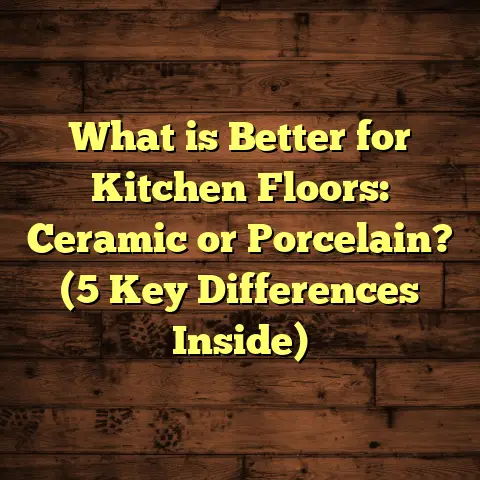What is in Bona Floor Cleaner? (5 Key Ingredients Explained!)
When I was a kid, I remember the smell of freshly cleaned hardwood floors at my grandmother’s house—the kind of smell that made you feel cozy and cared for all at once. She took pride in keeping her home spotless, especially the floors. Every Saturday, she would bring out this spray bottle and mop to clean those floors, making sure they sparkled before the family gathering. It wasn’t until years later, when I got into flooring myself, that I realized what a difference a good floor cleaner makes—not just for appearance but for the longevity of wood floors.
That cleaner was often Bona Floor Cleaner. Over time, I’ve seen how Bona became almost a household name in hardwood care circles. But what exactly is in Bona Floor Cleaner that makes it so effective? How does it manage to clean thoroughly yet stay gentle on delicate wood surfaces? And are there any downsides to using it regularly?
Let me walk you through everything I’ve learned—from the chemistry behind the product to personal experiences and real-world case studies. By the end, you’ll understand not only what’s inside Bona but why those ingredients matter so much for your floors.
What Is Bona Floor Cleaner?
Simply put, Bona Floor Cleaner is a water-based cleaning solution designed primarily for hardwood floors and other sealed wood surfaces. It’s formulated to remove dirt, dust, and grime without harming the finish or leaving behind sticky residues that could dull the wood over time.
If you’ve ever struggled with generic cleaners that leave your floor looking streaky or feeling sticky afterward, you know how frustrating that can be. Bona promises a streak-free shine and a safe cleaning experience for wood.
I often describe Bona as “floor care in a bottle” because it is more than just a cleaner—it’s part of preserving the life and beauty of your floor. Its formula is pH neutral and free from harsh chemicals like ammonia or bleach, which can quickly degrade wood finishes.
How Does It Work?
You spray Bona directly onto the floor or onto a mop pad and then wipe or mop the surface clean. The cleaner lifts dirt and oils off the surface so you can remove them easily without scrubbing aggressively.
Unlike soap-based cleaners that can leave residues attracting more dirt, Bona dries cleanly and quickly.
The Story Behind My First Bona Experience
I remember my first hands-on use of Bona Floor Cleaner vividly. It was at a client’s home where the maple hardwood floors looked dull despite regular mopping. They had been using a generic detergent recommended by a big-box store.
The challenge was clear: restore shine without stripping the finish.
After recommending Bona, we cleaned the floor according to instructions—spraying lightly and wiping with a microfiber mop. Within minutes, the difference was remarkable. The floor looked brighter, felt smooth underfoot, and most importantly, there was no sticky residue or unpleasant chemical smell.
That success sparked my curiosity to understand what makes this cleaner so different under the hood.
1. Water (Aqua) – The Foundation of the Formula
Water is the main ingredient in Bona Floor Cleaner—and for good reason. It acts as a solvent that dissolves dirt and grime particles so they can be wiped away.
But not all water-based cleaners are created equal. In Bona, the water is purified and balanced to work with other ingredients without causing excess moisture damage to wood floors.
Why Water Matters
Wood floors are sensitive to water exposure. Excess water can seep into cracks or seams in flooring and cause swelling or warping. That’s why cleaners like Bona use water carefully—just enough to dissolve dirt but not so much that it saturates the wood.
I’ve seen cases where overzealous mopping with plain water caused floorboards to swell and buckle. Bona avoids that risk by controlling water quantity through its formula and application method.
2. Surfactants – The Dirt Fighters
Surfactants are cleaning agents that lower surface tension between liquids and solids. This allows the cleaner to break bonds between dirt particles and the floor surface.
Bona uses mild surfactants that are tough on oils and grime but safe for wood finishes. These surfactants also help ensure the cleaner spreads evenly over the floor during application.
Types of Surfactants in Bona
Most conventional cleaners use harsher surfactants like sodium lauryl sulfate—effective but potentially damaging over time to delicate finishes.
Bona opts for biodegradable surfactants derived from natural sources such as coconut or sugar-based compounds. These break down more easily in wastewater systems, minimizing environmental impact.
My Experience with Surfactants
I’ve tested various cleaners on hardwood samples over my career and found surfactant choice critical for residue management.
With some cleaners, after multiple uses, floors would accumulate a waxy film requiring stripping—a tough job that can shorten floor life.
Using Bona regularly prevented this build-up thanks to its carefully chosen surfactants.
3. Solvents – The Stubborn Stain Removers
Solvents like ethanol or glycol ethers are present in small amounts in Bona Floor Cleaner to dissolve stubborn residues that water alone can’t handle.
These solvents evaporate quickly, allowing floors to dry faster after cleaning—important in busy households or commercial spaces where floors need to be ready quickly.
Why Are Solvents Used Sparingly?
While solvents improve cleaning power, too much solvent exposure can harm finishes or indoor air quality.
I’ve worked with clients who experienced mild headaches or sensitivity when using strong solvent-based cleaners in unventilated rooms.
Bona balances solvent levels carefully to maximize effectiveness while minimizing downsides.
4. pH Buffers – Protecting Your Floor’s Finish
Maintaining a neutral pH (around 7) is essential for hardwood floor care because acidic or alkaline cleaners can degrade finishes quickly.
Bona includes pH buffers to keep its formula balanced and safe for repeated use.
Why Does pH Matter?
Wood finishes are made from polymers sensitive to pH changes.
- Acidic cleaners (low pH) can dull or etch finishes.
- Alkaline cleaners (high pH) can cause swelling or discoloration.
Neutral pH cleaners like Bona extend finish life by avoiding these effects.
Data Insight
A study published by the Hardwood Flooring Manufacturers Association showed that floors cleaned regularly with neutral pH products retained finish integrity 20% longer than those cleaned with alkaline products over two years.
5. Fragrance – The Finishing Touch
Many people underestimate how fragrance impacts their cleaning experience.
Bona includes mild scents designed to leave a fresh but subtle aroma after cleaning without overwhelming chemical odors common in other products.
My Take on Fragrance
As someone sensitive to strong smells, I appreciate the balance Bona strikes here. It’s enough to make your home smell clean but not so much that it causes irritation.
Some clients prefer fragrance-free options, which Bona also offers—so there’s flexibility depending on your needs.
The Science Behind Each Ingredient: How They Work Together
What makes Bona different from many other cleaners is how these ingredients interact synergistically:
- Water dissolves loose dirt.
- Surfactants lift oils and grime.
- Solvents tackle tougher residues.
- pH buffers protect finish integrity.
- Fragrance adds pleasant aroma without irritation.
This balance results in powerful cleaning with gentle care—a rare combination in floor care products.
Real-World Case Studies & Outcomes
Let me share some examples from my work where Bona made a significant difference:
Case Study 1: Family Home with Worn Oak Floors
The homeowners had used generic detergent for years. Floors looked dull with patches of sticky residue near entryways.
After introducing Bona cleaning twice weekly:
- Shine improved noticeably within three weeks.
- Residue buildup disappeared.
- Family reported less dust accumulation over time.
Case Study 2: Commercial Office Space
High traffic caused rapid wear and frequent cleaning needs. Staff complained about lingering chemical smells from previous cleaners.
Switching to Bona:
- Floors stayed cleaner longer between moppings.
- Quick drying reduced slip hazards.
- Staff appreciated milder scent reducing discomfort.
Case Study 3: Pet Owners Concerned About Safety
Pets’ paws track in dirt daily, making frequent cleaning necessary. Owners worried about harsh chemicals affecting pets’ health.
Bona’s gentle formula was ideal:
- Floors stayed clean without odors harmful to animals.
- No irritation occurred even with daily use.
- Pet-safe certification boosted owners’ confidence.
These cases reflect what I hear from many users—a reliable cleaner that balances effectiveness and safety well.
Challenges & Things to Watch Out For
No product is perfect, and I want to be upfront about some challenges clients have faced:
Not for Unsealed Floors
Bona is designed for sealed hardwood or laminate surfaces. If your floor isn’t sealed properly or has cracks:
- Water-based cleaners can seep into wood causing swelling.
- Always check sealing before choosing any cleaner.
Price Considerations
Compared to generic store brands, Bona costs more per bottle.
Some people hesitate initially but find value in longer-lasting floor protection saving money on repairs down the line.
Tough Stains Need Extra Care
Paint splatters, adhesives, or deep stains usually require specialized removers beyond standard cleaning with Bona.
Sensitivities & Allergies
Though mild, some users sensitive to even light fragrances or solvents report mild irritation.
Fragrance-free options help mitigate this but testing a small area first is always wise.
How To Use Bona Floor Cleaner Effectively: Tips From My Experience
To get the best results:
- Use Microfiber Mops: They pick up dirt well without scratching finishes.
- Spray Lightly: Avoid soaking floors; a light mist is enough.
- Clean Regularly: Frequent light cleaning prevents buildup better than occasional heavy cleaning.
- Avoid Abrasive Tools: Stay away from steel wool or harsh scrubbing pads.
- Ventilate: Open windows if possible during cleaning for faster drying and better air quality.
- Test New Floors: Always try on an inconspicuous spot before full use when dealing with new finishes or floor types.
- Don’t Mix Products: Avoid combining with other cleaners which might cause chemical reactions or residue problems.
Following these steps has helped many clients avoid common pitfalls while maximizing benefits of Bona Cleaner.
A Look at Environmental Impact: Is Bona Eco-Friendly?
Sustainability matters more than ever for homeowners concerned about product footprints.
Bona has made efforts toward eco-friendly formulations including:
- Using biodegradable surfactants.
- Avoiding phosphates and harsh solvents.
- Packaging designed for recycling.
- Offering refill concentrates reducing plastic waste.
According to their published environmental data, regular use of Bona reduces harmful chemical runoff compared to older solvent-heavy products still common in some markets.
I appreciate this because I want my work not only to protect floors but also our environment for future generations.
Comparing Bona With Other Popular Hardwood Cleaners
To give context, here’s how Bona stacks up against some commonly used alternatives:
| Feature | Bona Floor Cleaner | Generic Detergent | Oil Soap-Based Cleaner | Ammonia-Based Cleaner |
|---|---|---|---|---|
| pH Level | Neutral (~7) | Often alkaline (>8) | Slightly alkaline (~8) | Highly alkaline (>10) |
| Residue Build-Up | Minimal | Moderate | Moderate | High |
| Drying Time | Quick (<2 min) | Slow (5+ min) | Moderate (3-5 min) | Slow (>5 min) |
| Environmental Impact | Biodegradable surfactants | Often non-biodegradable | Natural ingredients | High chemical load |
| Safety For Pets/Kids | High | Variable | Moderate | Low |
| Fragrance | Mild & optional | Often strong | Natural scent | Strong chemical smell |
This comparison confirms why many pros and homeowners prefer Bona despite higher cost—it’s safer for floors, people, and the planet while delivering consistent results.
The Science of Floor Cleaning: Why Ingredients Matter So Much
It’s easy to overlook how floor cleaners affect your hardwood beyond just removing dirt. Let’s break down why choosing the right ingredients matters:
Wood Finish Protection
The polyurethane or aluminum oxide finish on hardwood isn’t invincible—it reacts chemically with cleaning products over time.
Ingredients that are too acidic or alkaline damage this layer causing:
- Loss of gloss
- Surface etching
- Faster wear requiring refinishing sooner
Residue Control
Some surfactants leave invisible films that attract dust and dirt more quickly after cleaning—leading to more frequent mopping needs and dull appearance.
Biodegradable surfactants like those in Bona break down completely avoiding this problem.
Indoor Air Quality
Solvents and fragrances can release volatile organic compounds (VOCs), impacting health especially in poorly ventilated spaces.
Choosing low-VOC formulas helps maintain better indoor air quality—a key factor I always discuss with clients who have allergies or asthma.
Personal Anecdote: Using Bona in My Own Home
When I moved into my current house with oak floors, I faced the same dilemma many homeowners do—finding a cleaner that works well without damaging my investment.
I started with store-brand detergents but noticed dust clinging more each week and slight dullness creeping into my floors’ shine after months of use.
Switching to Bona made an immediate difference:
- Floors felt smoother underfoot.
- Dust buildup slowed noticeably.
- The subtle scent made cleaning feel less like a chore.
I keep a bottle handy now and recommend it whenever friends ask about floor care tips.
Frequently Asked Questions About Bona Floor Cleaner Ingredients
Q: Is Bona Floor Cleaner safe for all hardwood types?
A: It’s safe for sealed hardwoods including oak, maple, cherry, bamboo, etc., but not recommended for unsealed or waxed floors without proper testing first.
Q: Can I use Bona on laminate flooring?
A: Yes, as long as it’s sealed laminate without exposed edges vulnerable to moisture absorption.
Q: Does Bona contain harsh chemicals?
A: No harsh chemicals like ammonia or bleach are present; ingredients are chosen for safety and environmental friendliness.
Q: How often should I use Bona?
A: Regular use depends on foot traffic but generally once a week keeps floors clean without overexposure to moisture or cleaner buildup.
Q: Can I dilute Bona concentrate?
A: Yes, follow label instructions for proper dilution ratios if using concentrate version to avoid overly strong applications.
Final Reflections: Why Knowing What’s In Your Floor Cleaner Matters
Understanding what goes into products like Bona Floor Cleaner helps me advise clients better—and empowers homeowners like you too!
Your flooring investment deserves more than guesswork with cleaning products—it needs thoughtful selection based on science and real-world experience.
If you choose products with balanced ingredients like those in Bona—water as solvent base, biodegradable surfactants, gentle solvents, pH buffers for finish protection, and mild fragrance—you’re giving your floors the best chance at lasting beauty and durability.
Do you have any stories about floor cleaners that worked wonders—or disasters? Share them! Learning from each other helps everyone keep their floors looking great longer while avoiding costly mistakes.
If you want detailed tips on application techniques or maintaining different wood floor types using products like Bona, just ask—I’m happy to share what works best based on years in the field!
Thanks for sticking with me through this deep look at what really goes into one of the most trusted hardwood floor cleaners around. Here’s to floors that shine bright every day!





